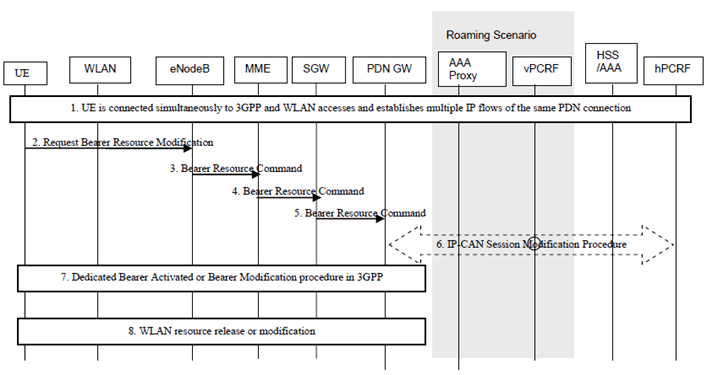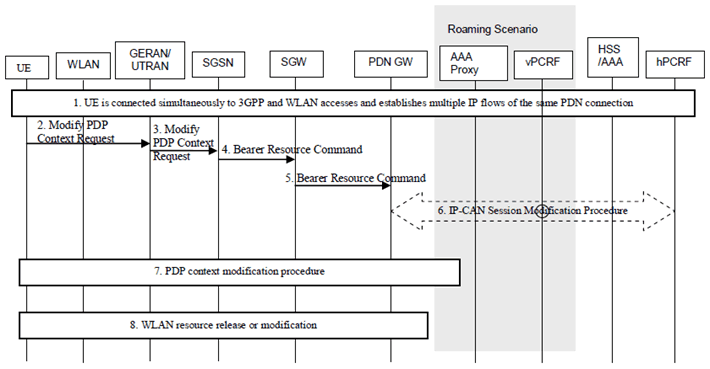Content for TS 23.161 Word version: 18.0.0
1…
5…
6…
6.2…
6.2.4
6.3…
6.3.2.2…
6.3.3…
6.3.3.2…
6.4…
6.4.2.2…
6.5…
6.5.2…
6.5.3…
6.6…
6.6.1.3…
6.6.2…
6.7…
6.7.2…
6.8…
6.3.3 UE-initiated IP flow mobility p. 33
6.3.3.1 Routing Rules signalled via 3GPP access p. 33
In the following signalling flows, they are applied to UE-initiated NBIFOM mode. The UE moves one or more IP flow(s) by providing a Routing Rule with access type 3GPP to update the routing rules via NAS and GTPv2 procedures. The routing rule is sent via E-UTRAN in this case.

Figure 6.3.3.1-1: UE-initiated IP flow mobility within a PDN connection via E-UTRAN using GTP
(⇒ copy of original 3GPP image)
(⇒ copy of original 3GPP image)
Step 1.
In the following signalling flows, they are applied to UE-initiated NBIFOM mode. The UE moves one or more IP flow(s) by providing a Routing Rule with access type 3GPP to update the routing rules via PDP context and GTPv2 procedures. The routing rule is sent via GERAN/UTRAN in this case.
The UE is connected simultaneously to 3GPP and WLAN accesses and establishes multiple IP flows of the same PDN connection.
Step 2.
The UE sends to the MME a Request Bearer Resource Modification message, which includes the Routing Rules requested by the UE.
Step 4-5.
The MME forwards the Routing Rules to the PDN GW via the Serving GW.
Step 6.
When dynamic PCC is applied for the PDN connection, the PDN GW initiates an IP-CAN Modification procedure and provides the Routing Rules in a notification to the PCRF. The PCRF may reject the IP flow mobility requests from UE due to subscription limitations. When the network rejects an IP flow mobility request, the network provides a certain cause value to the UE indicating why the request was rejected. This cause value may be used by the UE to determine when/if this IP flow mobility operation can be requested again.
Step 7.
The PDN GW performs the dedicated Bearer activation procedure or bearer modification procedure as described in TS 23.401, and indicates which the Routing Rule has been accepted.
Step 8.
Appropriate S2a/S2b resource release / modification procedures are executed for the resources associated with the flows that were removed from the Trusted or Un-trusted WLAN access as described in TS 23.402. For S2a-SCM, dedicated bearer over S2a is not supported when IP flow mobility is used.

Figure 6.3.3.1-2: UE-initiated IP flow mobility within a PDN connection via GERAN/UTRAN using GTP
(⇒ copy of original 3GPP image)
(⇒ copy of original 3GPP image)
This procedure is similar to 6.3.3.1-1 with the following differences:
Step 2-3.
The UE sends to the SGSN a Modify PDP Context Request message, which includes the Routing Rules requested by the UE.
Step 7.
The PDN GW performs the Secondary PDP context activation or PDP context modification procedure as described in TS 23.060, and indicates the Routing Rule has been accepted.